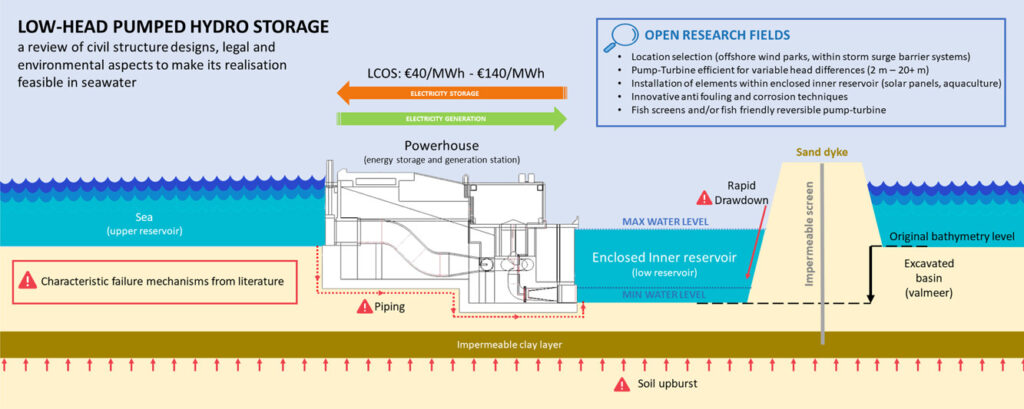New Publication: Low-Head Pumped Hydro Storage – A Review on Civil Structure Designs, Legal and Environmental Aspects to Make its Realization Feasible in Seawater
The energy transition requires large-scale storage to provide long-term supply and short-term grid stability. Though pumped hydro storage is widely used for this purpose, regions without natural topography do not have the potential for traditional high-head pumped hydro storage. To address this, multiple projects for low-head and seawater pumped hydro storage have been proposed, though few have been implemented.
Here, we review the state of the art of the components of low-head seawater pumped hydro storage projects, for construction in shallow seas or integrated into coastal defenses. We reference all civil infrastructure components, in addition to legal, environmental/biological, and financial constraints, drawing knowledge from proposed, planned, and constructed tidal power and seawater pumped hydro storage projects worldwide. Combining this knowledge, we make a preliminary evaluation of the feasibility for low-head seawater pumped hydro storage in the North Sea. We find that an elevated storage basin is more economical than an excavated one in shallow bathymetry (10 m deep or less), while the reverse is true in deeper water. Corrosion and fouling prevention are already well developed due to implementation of these measures at tidal power plants.
Dam construction is feasible if measures are taken to address piping, macro-instability (primarily from rapid drawdown), and bursting of the clay layer. Within the context of Europe, legal and environmental regulations may be the most formidable hurdles to such projects.

Highlights
• Low-head pumped hydro storage projects have been designed but never constructed.
• Technologies from tidal energy plants and the Yanbaru pumped hydro plant are useful.
• Research on the response of fish to stress induced by seawater pumped hydro is needed.
• Main failure mechanisms for low-head PHS are soil uplift, piping and rapid drawdown.
• Legal and regulatory aspects are limiting factors for projects development.
Authors: R. Ansorena Ruiz, L.H. de Vilder, E.B. Prasasti, M. Aouad, A. De Luca, B. Geisseler, K. Terheiden, S. Scanuf, A. Miccoli, V. Roeber, M. Marence, R. Moll, J.D. Bricker, N. Goseberg.

